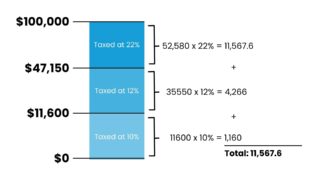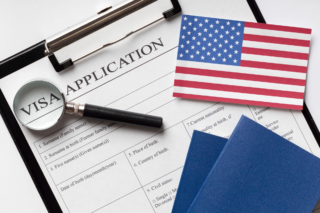
Have you ever asked yourself, “How do I even file taxes?”
It’s okay, we get how you feel. Everyone has gone through that phase.
Understanding how to navigate the complexities of the tax code can feel daunting. Fortunately, you don’t have to be a tax expert to file your taxes with confidence.
In this guide, we’ll walk you through the essential steps of filing taxes in the United States. We’ll cover the basics you need to know to successfully complete your tax return.
Why do I need to file taxes?
Before we get to the technical part, it’s important to understand why we are even filing taxes in the first place.
Just like regular people, the government needs money to fund essential government services and programs like Social Security, Medicare, and other public services.
Yet, even the government can’t make magic appear out of thin air. That’s where taxes come in. Through a certain percentage of taxpayers’ incomes, they are able to fund all activities that serve the betterment of the country.
Aside from being a mandatory requirement by the government, there are also several benefits to filing taxes such as:
- Potential Refunds: If taxes were withheld from your paycheck by your employer, you may be owed a refund.
- Social Security Benefits: For self-employed taxpayers, this is used to calculate Social Security Benefits.
- Proof of Income: Tax return is useful when applying for loans, mortgages, or government aid.
Who needs to file taxes?

Now, we come to the topic of who actually needs to pay taxes. While most working US citizens and permanent residents typically have to file a tax return, this is still dependent on the tax bracket you fall under based on age and annual income amount being earned.
You will need to file if your age falls under 65 by the end of the year and if you fall under any of the following categories:
| Filing Status | Gross Annual Income |
| Single | $14,600 or more |
| Head of household | $21,900 or more |
| Married filing jointly | $29,200 or more (both under 65) $30,750 or more (one under 65) |
| Married filing separately | $5 or more |
| Qualifying surviving spouse | $29,200 or more |
If you are 65 years old or older, then you will need to file if you fall under the following categories:
| Filing Status | Gross Annual Income |
| Single | $16,550 or more |
| Head of household | $23,850 or more |
| Married filing jointly | $30,750 or more (one under 65) $32,300 or more (both over 65) |
| Married filing separately | $5 or more |
| Qualifying surviving spouse | $30,750 or more |
When do I need to file taxes?
Filing taxes is always done on an annual basis. However, take note that you are always filing taxes for the income you earned the previous year.
For example, the tax filing season in 2025 is for the tax during 2024.
Typically, the deadline for taxes falls on April 15. However, it can move to the next business day if it falls on a weekend or holiday.
If you are not able to meet the deadline, then you may have to face penalties and fees. To make sure that you are not penalized, make sure to file on time or apply for a deadline extension.
How do I file taxes?
At this point, you might be already wondering how to file taxes. Don’t worry, this won’t be too complicated. Here’s a simple step-by-step guide:
Step 1: Determine If You Need to File
Before everything, make sure that you even need to pay taxes. Check the table in the “Who needs to file taxes?” portion of this article to determine if you need to file.
Step 2: Gather Tax Documents
Once you have determined the need to pay taxes, list down the IRS tax forms that you will be needing. It can be useful to have a checklist of what forms and information you need.
There are a lot of forms, but here’s a brief overview of commonly used ones:
- Form W-2 (Wage and Tax Statement): Provided by employers, showing your total earnings, tax withholdings, and Social Security/Medicare contributions.
- Form 1040 (US Individual Income Tax Return): The standard form used by individuals to file their annual income tax return.
- Form 1099-NEC (Nonemployee Compensation): Used by freelancers, gig workers, and independent contractors to report self-employment income.
- Form 1099-MISC (Miscellaneous Income): Reports various types of income like rent, royalties, or prizes that aren’t from employment.
- Form 1099-K (Payment Card and Third-Party Network Transactions): Sent by platforms like PayPal, Venmo, or Stripe if you receive $600 or more in business payments.
- Form 1099-INT (Interest Income): Issued by banks for taxable interest earned from savings accounts, CDs, or bonds.
- Form 1098 (Mortgage Interest Statement): Provided by lenders to homeowners showing mortgage interest paid, which may be deductible.
- Form 1098-T (Tuition Statement): Issued by colleges/universities for students or parents claiming education tax credits.
- Form 1098-E (Student Loan Interest Statement): Reports student loan interest paid, which may be deductible.
- Schedule C (Profit or Loss from Business): Used by self-employed individuals to report income and business expenses.
Step 3: Fill Out Tax Form
Now that you have the tax documents you need, all you have to do is fill them out.
Step 4: Filing
Once you have accomplished your tax forms, you can now file your tax returns. You can either file it in electronically, or file it through mailing the appropriate IRS address.
Step 5: Pay Owed Taxes
If you owe taxes, pay by April 15 to avoid penalties and interest. You can pay via:
- Direct debit from a bank account
- Credit/debit card (fees may apply)
- IRS payment plans (if you need more time)
Step 6: Track Your Refund (If Applicable)
If you are expecting a refund, you can check its status through the “Where’s My Refund” tool from the IRS.
What’s Next?

You’ve filed your tax return. Now what?
Technically, filing your taxes is usually the endpoint. However, there are some things that you have to take note of.
Keep your records
Don’t just throw away your tax records. Keep them in a secure place that is easy to remember. There are situations where your old tax records might be needed.
Update IRS when you change your address
An updated address is important because this is where the IRS will be sending you documents or verifying your identity.
If a change in address happens, make sure that you update the IRS using Form 8822.
Correcting mistakes after filing
You’ve already filed your return but notice that you’ve made a mistake. No worries, that can be fixed.
Usually, the IRS will catch minor mistakes or omissions but it’s possible that they correct it themselves and adjust your refund accordingly.
If you want to be sure or if the mistake is not minor, then you will need to file a Form 1040-X (Amended US Individual Income Tax Return).
However, make sure to wait until you get your refund before you do anything. You may not even need to submit an amended tax return if the IRS corrects it for you.
Frequently Asked Questions
What should I do if I can’t pay my taxes in full by the deadline?
If you’re unable to pay your taxes in full by the deadline, you should still file your tax return on time to avoid penalties for late filing. Consider setting up an installment agreement with the IRS to pay your taxes over time, or explore other payment options available through the IRS.
What happens if I miss the tax filing deadline?
If you miss the tax filing deadline, you may be subject to penalties and interest on any unpaid taxes. It’s essential to file your tax return as soon as possible to minimize potential penalties. If you’re due a refund, there’s generally no penalty for filing late, but you must file within three years to claim your refund.
What are the consequences of filing taxes late?
Filing taxes late may result in penalties and interest charges on any unpaid taxes owed. The penalty for filing late is typically 5% of the unpaid tax amount per month, up to a maximum of 25% of the unpaid tax. It’s essential to file your tax return on time, even if you can’t pay the full amount owed, to avoid additional penalties.
Can I file my taxes electronically if I’m filing for the first time?
Yes, you can file your taxes electronically (e-file) even if it’s your first time filing. Many tax preparation software programs offer step-by-step guidance for first-time filers, making the process straightforward and efficient.
I received a tax refund last year. Will I receive one again this year?
Whether or not you receive a tax refund depends on various factors, including changes in your income, deductions, and tax credits from year to year. Additionally, if you had more taxes withheld from your paychecks than necessary, you may receive a refund, but if you owe taxes or didn’t have enough withheld, you may owe additional taxes.
Can I deduct expenses related to working from home on my taxes?
As of 2024, employees who work from home due to COVID-19 are generally unable to deduct home office expenses on their taxes. However, self-employed individuals and independent contractors may still be eligible to deduct qualifying home office expenses. It’s advisable to consult with a tax professional for guidance on specific deductions.
What should I do if I lost my tax documents or didn’t receive them?
If you lost your tax documents or did not receive them, you can request duplicates from the issuing party, such as your employer or financial institution. Additionally, you can access certain tax documents electronically through online accounts or contact the IRS for assistance in obtaining copies of prior-year tax transcripts. Keeping accurate records and maintaining backups of important documents can help prevent issues with lost or missing tax documents in the future.

Stay Updated.
Get the latest news, guides, and forms.
Thank you!
You have successfully joined our subscriber list.


